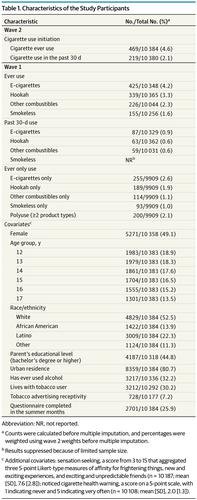当前位置:
X-MOL 学术
›
JAMA Pediatr.
›
论文详情
Our official English website, www.x-mol.net, welcomes your feedback! (Note: you will need to create a separate account there.)
Association of Noncigarette Tobacco Product Use With Future Cigarette Smoking Among Youth in the Population Assessment of Tobacco and Health (PATH) Study, 2013-2015
JAMA Pediatrics ( IF 26.1 ) Pub Date : 2018-02-01 , DOI: 10.1001/jamapediatrics.2017.4173 Shannon Lea Watkins 1 , Stanton A. Glantz 2 , Benjamin W. Chaffee 3
JAMA Pediatrics ( IF 26.1 ) Pub Date : 2018-02-01 , DOI: 10.1001/jamapediatrics.2017.4173 Shannon Lea Watkins 1 , Stanton A. Glantz 2 , Benjamin W. Chaffee 3
Affiliation

|
Importance Approximately 90% of adult smokers first tried a cigarette by 18 years of age, and even infrequent smoking in adolescence is associated with established adult smoking. Noncigarette tobacco use is increasing and could stimulate subsequent conventional cigarette smoking in youths. Objective To estimate the longitudinal association between noncigarette tobacco use and subsequent cigarette smoking initiation among US youth. Design, Setting, and Participants In this prospective cohort study of the Population Assessment of Tobacco and Health (PATH) waves 1 (September 12, 2013, to December 14, 2014) and 2 (October 23, 2014, to October 30, 2015), a nationally representative sample of youths who never smoked a conventional cigarette at baseline and completed wave 2 follow-up (N = 10 384) was studied. PATH retention at follow-up was 87.9%. Exposures Ever use and past 30-day use of electronic cigarettes (e-cigarettes), hookah, noncigarette combustible tobacco, or smokeless tobacco at baseline. Main Outcomes and Measures Ever use and past 30-day use of cigarettes at follow-up. Results The present analysis was based on the 10 384 PATH youth respondents who reported never having smoked a cigarette in wave 1 and whose cigarette ever or past 30-day use was reported in wave 2 (mean [SD] age, 14.3 [1.7] years; age range, 12-17 years; 5087 [49.1%] female; 4829 [52.5%] white). At 1-year follow-up, 469 (4.6%) of all baseline never-smoking youths had tried a cigarette and 219 (2.1%) had smoked a cigarette within the past 30 days. Cigarette ever use at follow-up was higher among youths who had ever used e-cigarettes (78 [19.1%]), hookah (60 [18.3%]), noncigarette combustible tobacco (45 [19.2%]), or smokeless tobacco (29 [18.8%]) at baseline. After adjusting for sociodemographic, environmental, and behavioral smoking risk factors and for baseline ever use of other tobacco products, the odds of past 30-day cigarette use at follow-up were approximately twice as high among baseline ever users of e-cigarettes (odds ratio [OR], 1.87; 95% CI, 1.15-3.05), hookah (OR, 1.92; 95% CI, 1.17-3.17), noncigarette combustible tobacco (OR, 1.78; 95% CI, 1.00-3.19), and smokeless tobacco (OR, 2.07; 95% CI, 1.10-3.87). Youths who had tried more than 1 type of tobacco product at baseline had 3.81 (95% CI, 2.22-6.54) greater adjusted odds of past 30-day cigarette smoking at follow-up than did baseline never tobacco users. Conclusions and Relevance Any use of e-cigarettes, hookah, noncigarette combustible tobacco, or smokeless tobacco was independently associated with cigarette smoking 1 year later. Use of more than 1 product increased the odds of progressing to cigarette use.
中文翻译:

2013-2015 年烟草与健康人口评估 (PATH) 研究中非卷烟烟草产品使用与青年未来吸烟的关联
重要性 大约 90% 的成年吸烟者在 18 岁时首次尝试吸烟,即使是在青春期不经常吸烟也与成人吸烟有关。非卷烟烟草的使用正在增加,并可能刺激年轻人随后吸烟。目的 评估美国青年非吸烟烟草使用与随后开始吸烟之间的纵向关联。设计、设置和参与者 在这项针对烟草与健康人口评估 (PATH) 第一波(2013 年 9 月 12 日至 2014 年 12 月 14 日)和第二波(2014 年 10 月 23 日至 2015 年 10 月 30 日)的前瞻性队列研究中,研究了在基线时从未吸过传统香烟并完成第 2 波随访(N = 10 384)的全国代表性青年样本。随访时 PATH 保留率为 87.9%。暴露 在基线时曾经和过去 30 天使用过电子烟(电子烟)、水烟、非香烟可燃烟草或无烟烟草。主要结果和措施 随访时曾使用和过去 30 天使用香烟。结果 本分析基于 10 384 名 PATH 青年受访者,他们在第 1 波中报告从未吸烟,并且在第 2 波中报告其曾经或过去 30 天使用过香烟(平均 [SD] 年龄,14.3 [1.7] 岁) ;年龄范围,12-17 岁;5087 [49.1%] 女性;4829 [52.5%] 白人)。在 1 年的随访中,469 名 (4.6%) 的基线从不吸烟青少年在过去 30 天内尝试过卷烟,219 名 (2.1%) 曾吸过一支烟。曾使用过电子烟的青少年 (78 [19.1%])、水烟 (60 [18.3%])、非香烟可燃烟草 (45 [19. 2%]) 或无烟烟草 (29 [18.8%]) 在基线。在调整社会人口统计、环境和行为吸烟风险因素以及其他烟草产品的基线使用情况后,在随访时过去 30 天使用香烟的几率在基线电子烟用户中大约高两倍(几率比率 [OR],1.87;95% CI,1.15-3.05),水烟(OR,1.92;95% CI,1.17-3.17),非卷烟可燃烟草(OR,1.78;95% CI,1.00-3.19)和无烟烟草烟草(OR,2.07;95% CI,1.10-3.87)。在基线时尝试过 1 种以上烟草产品的青少年在随访时过去 30 天吸烟的调整几率比基线从不吸烟者高 3.81(95% CI,2.22-6.54)。结论和相关性 任何使用电子烟、水烟、非香烟可燃烟草、或无烟烟草与 1 年后吸烟独立相关。使用超过 1 种产品会增加吸烟的几率。
更新日期:2018-02-01
中文翻译:

2013-2015 年烟草与健康人口评估 (PATH) 研究中非卷烟烟草产品使用与青年未来吸烟的关联
重要性 大约 90% 的成年吸烟者在 18 岁时首次尝试吸烟,即使是在青春期不经常吸烟也与成人吸烟有关。非卷烟烟草的使用正在增加,并可能刺激年轻人随后吸烟。目的 评估美国青年非吸烟烟草使用与随后开始吸烟之间的纵向关联。设计、设置和参与者 在这项针对烟草与健康人口评估 (PATH) 第一波(2013 年 9 月 12 日至 2014 年 12 月 14 日)和第二波(2014 年 10 月 23 日至 2015 年 10 月 30 日)的前瞻性队列研究中,研究了在基线时从未吸过传统香烟并完成第 2 波随访(N = 10 384)的全国代表性青年样本。随访时 PATH 保留率为 87.9%。暴露 在基线时曾经和过去 30 天使用过电子烟(电子烟)、水烟、非香烟可燃烟草或无烟烟草。主要结果和措施 随访时曾使用和过去 30 天使用香烟。结果 本分析基于 10 384 名 PATH 青年受访者,他们在第 1 波中报告从未吸烟,并且在第 2 波中报告其曾经或过去 30 天使用过香烟(平均 [SD] 年龄,14.3 [1.7] 岁) ;年龄范围,12-17 岁;5087 [49.1%] 女性;4829 [52.5%] 白人)。在 1 年的随访中,469 名 (4.6%) 的基线从不吸烟青少年在过去 30 天内尝试过卷烟,219 名 (2.1%) 曾吸过一支烟。曾使用过电子烟的青少年 (78 [19.1%])、水烟 (60 [18.3%])、非香烟可燃烟草 (45 [19. 2%]) 或无烟烟草 (29 [18.8%]) 在基线。在调整社会人口统计、环境和行为吸烟风险因素以及其他烟草产品的基线使用情况后,在随访时过去 30 天使用香烟的几率在基线电子烟用户中大约高两倍(几率比率 [OR],1.87;95% CI,1.15-3.05),水烟(OR,1.92;95% CI,1.17-3.17),非卷烟可燃烟草(OR,1.78;95% CI,1.00-3.19)和无烟烟草烟草(OR,2.07;95% CI,1.10-3.87)。在基线时尝试过 1 种以上烟草产品的青少年在随访时过去 30 天吸烟的调整几率比基线从不吸烟者高 3.81(95% CI,2.22-6.54)。结论和相关性 任何使用电子烟、水烟、非香烟可燃烟草、或无烟烟草与 1 年后吸烟独立相关。使用超过 1 种产品会增加吸烟的几率。



























 京公网安备 11010802027423号
京公网安备 11010802027423号